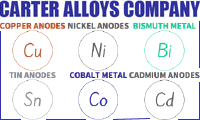
Curated with aloha by
Ted Mooney, P.E. RET

The authoritative public forum
for Metal Finishing 1989-2025

-----
Sulphamate Nickel "Dummy Cathodes"
Q. I am planning to fabricate a Corrugated Dummy to Plate Impurities out of my Nickel Sulphamate Plating Tank. I am looking for suggestions for use of correct material in making this Dummy. Should it be Mild Steel or Stainless Steel or Nickel Alloy ?
Additionally, a sample drawing to define shape of such dummy cathode may also be provided.
Thanks,
Plating Shop Employee - Karachi, Pakistan
January 3, 2008
First of two simultaneous responses --
A. Dear Muhammad
There's no need to use stainless steel or nickel alloys. It would be even difficult to make an appropriate pre-treatment for that substratum. Mild steel or brass is the most frequently in use. If you are going to use the "dummy" several times, I would recommend the brass one, if once - mild steel. The shape is not so important as the say. In fact, the plate needn't even be corrugated, however it helps in observing the results of cleaning. The parameters of cleaning are more significant.
- Warsaw, Poland
January 4, 2008
Second of two simultaneous responses --
A. Any of the material you proposed is OK. Mild steel will be the less expensive and if care is taken not to let it dissolve (like too much reverse or inadvertently left in the solution w/o current), it will not harm your bath at all. Stainless is more forgiving but more expensive. Nickel is totally safe but most expensive of all. Corrugations may be bent at 90o to a 1/4" radius or less and 2 to 4 inches deep (peak to valley). It should be LARGE considering your bath size. Remember to inspect the dummy after use to avoid over utilization (waste nickel) and clean it before re-use. Sand blasting is our preferred method but any mechanical method is acceptable provided it leaves its surface clean again.
Guillermo MarrufoMonterrey, NL, Mexico
January 5, 2008
Do we need to "leach" nickel anode squares and dummy cathodes?
February 27, 2014Dear all,
I've a question about cleaning your dummy cathode, and actually your anode(s) as well. So much care is taken cleaning the solution when it is freshly made up. You have to leach the tank and anode bags etc. . . but I can't find any mention in my literature about cleaning your anode and dummy cathode. Surely there must be some organic contamination because of handling? I am tempted to clean my SS dummy with acetone
⇦ this on
eBay
or
Amazon
[affil links] Warning! highly Flammable!
followed by a 1:? HCl etch. Same for my nickel anodes (pure nickel squares). Is that alright to do or what would you recommend? Thanks for your reply!

Wesley van de Ven
- Weert, Netherlands
A. Hello Wesley,
It's good to hear someone is concerned about the proper way to kick off a new bath. If your company is going to spend good money on a new bath, you want to start off right. I've always used Ni "S Rounds", and they always came in clean from the supplier, so no cleaning was necessary. With the Ni squares, you could put them through a hot acid soak cleaner with a little manual agitation for 5 mi, triple cascade rinse then bag the anodes. When the anodes are bagged, I like to go through a 10% sulfuric dip for 1 minute (for Ni sulphate baths), or a HCl dip for Chloride Strike Baths, rinse in DI water for 30 seconds, then put them in the tank. The cathode dummy panel can be cleaned as you were to clean steel in your plant followed by an HCl dip. I don't think acetone is needed. Good Luck!!!
process engineer - Malone, New York
February 28, 2014
March 3, 2014
![]() Thanks Mark for the good advice!
Thanks Mark for the good advice!
cheers,
Wesley

Wesley van de Ven
- Weert, Netherlands
adv.: Supplier of Copper Anodes, Nickel Anodes, Bismuth Metal, & Other Metal Products for Industry & The Arts

Q, A, or Comment on THIS thread -or- Start a NEW Thread